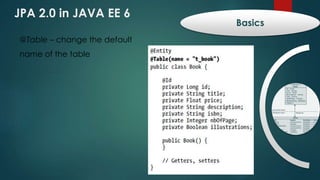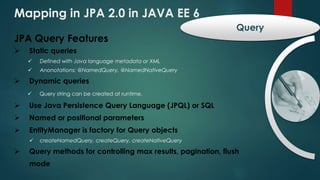Jpa 2.0 in java ee 6 part ii
- 1. JPA 2.0 in JAVA EE 6 Basics Mapping Query Transaction and Concurrency
- 2. JPA 2.0 in JAVA EE 6 Basics What is JPA? Java EE Standard ORM Framework JPA 2.0 (JSR 317) JPA 1.0 part of EJB 3.0 JSR 220 JPA 2.0 standalone JSR 317 JPA 2.1 (JSR 338) included in Java EE 7 Enables transparent POJO Persistence Handles Object Relational impedance mismatch Enables building persistent objects following common OOP concepts
- 3. JPA 2.0 in JAVA EE 6 Basics Why JPA?
- 4. JPA 2.0 in JAVA EE 6 Basics Why JPA?
- 5. JPA 2.0 in JAVA EE 6 Basics Java Persistence Features Simplify the persistence programming Default over configuration (Convention over configuration ) Elimination of deployment descriptor Provide light-weight persistence model In both programming model and deployment Runtime performance Enable testability outside of the containers Enables test-driven development Test entities as part of nightly-buid process
- 6. JPA 2.0 in JAVA EE 6 Basics Java Persistence Features Support rich domain modelling Support inheritance and polymorphism among entities Provide standardized and efficient ORM Optimized for relational database Standardize annotations and XML configuration files Provide extensive querying capabiliies Support for pluggable, third-party persistence providers. Through persistence unit – represented by persistence.xml Persistence API expanded to include use outside EJB container Evolved into “common” Java persistence API between Java SE and Java EE apps
- 7. JPA 2.0 in JAVA EE 6 Basics JPA Architecture Java Application Java Persistence API Hibernate EclipseLink Kodo (OpenJPA) Everyone can use their own favorite persistence technology
- 8. JPA 2.0 in JAVA EE 6 Basics Entity Plain Old Java Object (POJO) Supports OO programming model, (PIE) Can be in either persistent(manage) or non-persistent state (detached) Example of non-persistent state is “transient” state Have persistent identity When it is in managed state Can extend other entity and non-entity classes (Inheritance) Serializable; usable as detached objecs in other tiers
- 9. JPA 2.0 in JAVA EE 6 Basics Simple Mapping Mapping defaults to matching column name. Default Mapping Entity name -> table name (customizable via @Table) Attribute name -> column name(customizable via @Column) Data type mapping (some differences among databases) String -> VARCHAR(255) Long, long -> BIGINT Double, double -> DOUBLE Boolean -> SMALLINT
- 10. JPA 2.0 in JAVA EE 6 Basics Entity Class (@Entity) Annotated with @Entity Can extend another entity Can be a concrete or abstract class Programming requirement Must have a primary key field Must have a public no-arg constructor Instance variables must not be public Must not be final or have final methods
- 11. JPA 2.0 in JAVA EE 6 Basics Entity Identity (@Id, @GeneratedValue ) Every entity has a persistence identity Maps to primary key in database Cancorrespond to simple type @Id – single field/property in entity class @GeneratedValue – value can be generated automatically using various strategies AUTO – Choose type depending on database, e.g: IDENTITY for MySQL IDENTITY – using a database identity column SEQUENCE – using a database sequence TABLE – Use a sequence table for key generation (most portable)
- 12. JPA 2.0 in JAVA EE 6 Basics O/R Mapping Annotations Set of annotations defined for mapping (Relationships, Joins, Database tables and columns) An Example Data Model Maps entity state to data store Maps relationships to other entities
- 13. JPA 2.0 in JAVA EE 6 Basics @Table – change the default name of the table
- 14. JPA 2.0 in JAVA EE 6 Basics @SecondaryTables – associates a secondary table
- 15. JPA 2.0 in JAVA EE 6 BasicsO/R Mapping Annotations
- 16. JPA 2.0 in JAVA EE 6 Basics @Column – changes attibutes of the column such as the name, length and whether allows NULL or NOT.
- 17. JPA 2.0 in JAVA EE 6 Basics
- 18. JPA 2.0 in JAVA EE 6 Basics @Basic – overrides basic persistence fetch.LAZY fetch.EAGER
- 19. JPA 2.0 in JAVA EE 6 Basics @Temporal – provides representation of date, hour or milliseconds
- 20. JPA 2.0 in JAVA EE 6 Basics
- 21. JPA 2.0 in JAVA EE 6 Basics @Enumerated – maps the enum values as Text( ORDINAL default)
- 22. JPA 2.0 in JAVA EE 6 Basics @Transient – disables the mapping of a given attribute
- 23. JPA 2.0 in JAVA EE 6 Basics @CollectionTable – specifies the table that is used for the mapping of collection of basic or embeddable types. @ElementCollection – inform the persistence provider rerence is a set of collection and defines the “fetch” mode.
- 24. JPA 2.0 in JAVA EE 6 Basics
- 25. JPA 2.0 in JAVA EE 6 Basics DEMO
- 26. JPA 2.0 in JAVA EE 6 Basics Concepts of JPA Operations Entity Manger Persistent context Persistent unit
- 27. JPA 2.0 in JAVA EE 6 Basics Life Cycle of an Entity
- 28. JPA 2.0 in JAVA EE 6 Basics DEMO
- 29. JPA 2.0 in JAVA EE 6 End of Part I Basics Part II – Mapping Thank you for your patience…. [email protected] Lars Lemos toplars
- 30. JPA 2.0 in JAVA EE 6Mapping
- 31. Mapping in JPA 2.0 in JAVA EE 6 Mapping Types of Entity Relationship Directionality Uni-directional Bi-directional Cardinality relationships One to one One to many Many to many Inheritance relationship Single table Joined Table
- 32. Mapping in JPA 2.0 in JAVA EE 6 Mapping Directionality & Ownership Relationship has an ownership Who owns the relationship affects how tables are created. Uni-directional Ownership is implied Bi-directional Ownership needs to be explicitly specified. Owner of the relationship, inverse-owner of the relationship.
- 33. Mapping in JPA 2.0 in JAVA EE 6 Mapping Directionality & Navigation Directionality affects the navigation Uni-directional customer.getAddress() is allowed but address.getCustomer() is not supported for 1-1 relationship customer.getOrders() is allowed but order.getCustomers() is not supported for 1-m relationship. speaker.getEvents() is allowed but event.getSpeakers() is not supported for n- m relationship. Bi-directional Navigation on both direction
- 34. Mapping in JPA 2.0 in JAVA EE 6 Mapping Cardinality Relationship Cardinality relationships @OneToOne : Customer – Address @OneToMany: Customer – Orders @ManyToMany : Speakers – Events @ManyToOne: Employee - Project One-to-Many and Many-to-Many relationships are represented in Java code through Collection, Set, List and Map
- 35. Mapping in JPA 2.0 in JAVA EE 6 Mapping Uni-directional Mappings @OneToOne : Employee – ParkingSpace
- 36. Mapping in JPA 2.0 in JAVA EE 6 Mapping Uni-directional Mappings @ManyToOne : Employee – Department
- 37. Mapping in JPA 2.0 in JAVA EE 6 Mapping Bi-directional Mappings @OneToOne : Employee – ParkingSpace The owner is the side with he foreign key
- 38. Mapping in JPA 2.0 in JAVA EE 6 Mapping Bi-directional Mappings @OneToMany: Employee – Department The owner is always the “Many” side
- 39. Mapping in JPA 2.0 in JAVA EE 6 Mapping Bi-directional Mappings @ManyToMany: Employee – Project
- 40. Mapping in JPA 2.0 in JAVA EE 6 Mapping Embedded Objects @ManyToMany: Employee – Project
- 41. JPA 2.0 in JAVA EE 6Query
- 42. Mapping in JPA 2.0 in JAVA EE 6 Query JPA Query Features Static queries Defined with Java language metadata or XML Anonotations: @NamedQuery, @NamedNativeQuery Dynamic queries Query string can be created at runtime. Use Java Persistence Query Language (JPQL) or SQL Named or positional parameters EntityManager is factory for Query objects createNamedQuery, createQuery, createNativeQuery Query methods for controlling max results, pagination, flush mode
- 43. Mapping in JPA 2.0 in JAVA EE 6 Query JPQL
- 44. Mapping in JPA 2.0 in JAVA EE 6 Query Named query Queries tha can be reusable.
- 45. Mapping in JPA 2.0 in JAVA EE 6 Query Named query
- 46. Mapping in JPA 2.0 in JAVA EE 6 Query Dynamic Query Build and execute queries dynamically at runtime.
- 47. Mapping in JPA 2.0 in JAVA EE 6 Query Native Query Build and execute queries based on native SQL.
- 48. JPA 2.0 in JAVA EE 6 Mapping & Querying DEMO
- 49. JPA 2.0 in JAVA EE 6 End of Part III Basics Part IV – Advanced JPA & Transactions Thank you for your patience…. [email protected] Lars Lemos toplars

















































